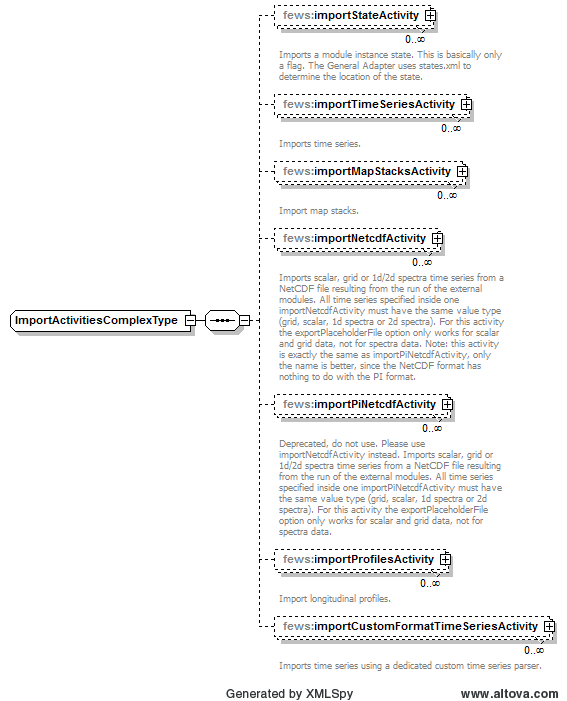...
ExportAreaSelectionActivity
ExportLocationAreaActivity
Execute Activities
Figure 75 Elements of the ExecuteActivity configuration
executeActivity
Exports an area selection mask as a PiMapStack. This activity requires an embedded polygon to be specified within the areaSelectionShapeFileBase64 field of the TaskProperties. This file is then available to be used by the pre and post adapter.
description
Optional description for the activity. Used for reference purposes only.
ExportLocationAreaActivity
Exports an area selection mask in the form of a PiMapStack. This activity requires selectedLocationIds to be specified within the TaskProperties. This selection is then available to be used by the pre and post adapterRoot element for the definition of an execute activity. For each external executable or Java class to run, an executeActivity must be defined. Multiple entries may exist.
description
Optional description for the activity. Used for reference purposes only.
command
Root element to define command to execute.
...
exportFile
File name
...
of the file to be exported. Always placed into the export dir.
gridLocationId
Locations that contains the reference grid information.
gridFormat
Format of the PiMapStack file. Can be
- ascii,
- ascii_llcorner,
- pcrgrid or
- usgs (Bil format)
polygonLocationId
Execute Activities
Figure 75 Elements of the ExecuteActivity configuration
executeActivity
Root element for the definition of an execute activity. For each external executable or Java class to run, an executeActivity must be defined. Multiple entries may exist.
description
Optional description for the activity. Used for reference purposes only.
command
Root element to define command to execute.
- executable - File name and location of the executable to run the command is an executable. The file name may include environment variables, as well as tags defined in the general adapter or on the global.properties.
- className - Name of Java Class to run if the command defined as a Java class. This class may be made available to DELFT-FEWS in a separate JAR file in the \Bin directory.
- binDir - Directory executable to run the command is an executable. The file name may include environment variables, as well as tags defined in the general adapter or on the global.properties.
- className - Name of Java Class to run if the command defined as a Java class. This class may be made available to DELFT-FEWS in a separate JAR file in the \Bin directory.
- binDir - Directory with jar files and optionally native dlls. When not specified the bin dir and classloader of FEWS is used. When specified the java class is executed in a private class loader, it will not use any jar in the FEWS bin dir. Only one class loader is created per binDir, adapters should still not use static variables. All dependencies should also be in this configured bin dir.
...
Figure 76 Elements of the ImportActivities configuration
description
Optional description of import activity. Used for reference purposes only
...
Root element for importing grid time series in Pi-Netcdf format. importFile and timeSeriesSet should be defined.
importProfilesActivity
...
Netcdf format. importFile and timeSeriesSet should be defined.
importProfilesActivity
Root element for importing longitudinal profile time series resulting from the run of the external modules. Multiple elements may be defined. importFile and timeSeriesSet should be defined.
exportPlaceholdFile
If <exportPlaceholderFile>true</exportPlaceholderFile>, then the General adapter will generate placeholder files. A placeholder file is a file with headers only, without timeseries. Its name is the same as filename configured for the ImportActivity and this placeholderfile is written to the import directory. The placeholder files are written before any execute activity is started. The models cq model adapters should read this placeholder files to see which data should be provided to import in FEWS.
- <importTimeSeriesActivity> writes headers to pi_timeseries.xml
- <importMapStacksActivity> writes headers to pi_mapstacks.xml
- <importPiNetcdfActivity> writes headers to NC file
- <importProfilesActivity> writes headers to pi_profiles.xml
The intention behind this exportPlaceholderFile functionality is that the model cq modeladapter reads the placeholders to see which timeseries are required by Fews.
After simulation, the model cq modeladapter overwrites these files with its own data over the placeholder files ready to be imported by the import activity
exportPlaceholdFile
If <exportPlaceholderFile>true</exportPlaceholderFile>, then the General adapter will generate placeholder files. A placeholder file is a file with headers only, without timeseries. Its name is the same as filename configured for the ImportActivity and this placeholderfile is written to the import directory. The placeholder files are written before any execute activity is started. The models cq model adapters should read this placeholder files to see which data should be provided to import in FEWS.
| Code Block | ||||
|---|---|---|---|---|
| ||||
<importTimeSeriesActivity>
<exportPlaceholderFile>true</exportPlaceholderFile>
<importFile>output.xml</importFile>
<timeSeriesSets>
....
</timeSeriesSets>
</importTimeSeriesActivity>
|
...


